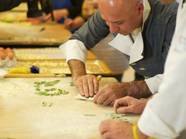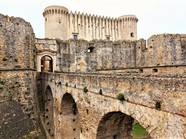The Eternal City: 3000 Years and Not Feeling Them (Almost)
The Dying Gaul, a masterpiece of antiquity from the first or second century AD, is on display at the National Gallery of Art in Washington through March 16th. Yet another work of art to visit the States just months after the Boxer at the Met, the Dying Gaul left Rome to act as the Italian capital’s spokesperson overseas. It is the Dying Gaul’s first trip since Napoleon carried it off to Paris in 1797. This time, the statue was personally accompanied by the mayor of Rome, whom we met up with in New York.
“It’s an extremely valuable statue, one of the most beautiful in our museums, but it’s also kind of an ‘ambassadorial’ symbol of how we would like the world to see Rome in the coming years,” says Marino, just before attending a lunch organized by the Columbus Citizens Foundation.
“My administration and I think that Rome needs to gain back its international role and bolster its relationship with the United States. Rome has an extraordinary wealth of art and culture and archaeological artifacts, which mustn’t simply be hoarded. They must be appreciated. To do that we want to pool those intelligences and resources that exist throughout the world, beginning with the US.”
The exhibition in Washington is part of the “Dream of Rome” project. How did it get that name? “It’s a name that resonates, I think, with the entire planet. When someone faraway plans his trip to Rome, whether he be in San Francisco or Oklahoma or Kansas City or New York, he has the impression he’s planning or designing the trip of his life. Rome is a city that’s been around for almost 3,000 years; you can find the origins of our planet’s civilization here, from jurisprudence to art to science. So I think it’s very important that we not only restore an eternal role to the city of Rome, but share it with the rest of the planet as well. For example, I think that a street everybody knows, Via dei Fori Imperiali, needs to undergo some changes if we want to keep up the digs to reunify the whole project for the largest archaeological park on the planet. In fact, it makes for a unique, marvelous space to really work on, and I believe that such an effort can involve scholars, archaeologists, and people who have social and political responsibilities outside our country.”
So the intention is to bring Rome to America and then bring America back to Italy and Rome. You lived abroad for a long time, particularly in the US. If I’m not mistaken you have dual citizenship...
“I do have dual citizenship— American and Italian. I lived and worked in the United States for almost 20 years. At a certain point, I thought it was opportune to apply for American citizenship, for many reasons. One reason was that I got a lot from this country: I mostly owe my training as a transplant surgeon to the US, and, clearly, after having lived here for so long, I feel closely connected to the country.”
And you’ve seen firsthand how Rome is perceived and was perceived here. You are in a unique position to acquaint Americans with the Eternal City. You know how to describe it, how to engage the popular imagination...
“Of course this country has changed a lot since I first came here, around the mid-Eighties, now that we’re in the third millennium. Remembering how Italy was perceived back then still brings a smile to my face. In the Eighties, almost 90% of United States citizens didn’t have passports. That means that only a small part of the society traveled, knew Italy, Europe, and the rest of the world.
I remember one day, during the first years I was specializing in transplant surgery, the head nurse on my ward (a ward with state-of-the-art technology that performed as many as 500 liver transplants a year) asked me if we had refrigerators in Italy. That was the idea they had of Italy and it was linked to the fact that the world communicated in a much slower way back then; there was no internet, no social networks, no Facebook. Today the knowledge of Italy in this country is clearly more vast from many points of view—cultural, gastronomic, intellectual, political, social—and I think that both countries have benefited as a result.”
On a personal level, if you had to convince an American to return to or visit the city for the first time in just a few words, what would you say?
“I would say that Rome is still the capital of the largest artistic, cultural, and archaeological patrimony on the planet, and an American can discover the origins of most of Western Civilization here. Here, he can gain a greater understanding of where he comes from, and that helps us decide which direction we want to be heading in.”
You might say Rome is a city for everybody. It also has a long Jewish heritage that ties it to New York too. You might say that’s a real point of comparison...
“Right. Rome is not only known for being the center of Christianity, for obvious reasons, it is also home to the oldest Jewish community in Italy and Europe. The Jewish community is very important to Rome. It has been for millennia. Unfortunately in the last century it suffered horribly. Under Mussolini’s dictatorship we had race laws, deportations, extermination—those had a dramatic affect on the city, a significant impact on the history of our community, meaning the community as a whole: the urban community of Rome. At the same time, you shouldn’t forget that Rome has the largest mosque in Italy and the largest Buddhist temple on the entire European continent. Rome is in a privileged position to act as a port of call, a cultural melting pot, and a religious mecca.
The number of itineraries to plan in Rome is endless, and unfortunately we don’t have enough space here to mention them all. So, on a personal level again, since I know you love biking, what itinerary would you recommend for someone biking through the city?
“Definitely the historic center of Rome, starting with Piazza del Popolo, crossing Via del Corso, stopping by Via del Tritone and the area around the Trevi Fountain. Then I’d head back www.i-Italy.org 05_TOURISM-Roma-lilith.indd 57 toward Piazza di Spagna and connect up with Via del Babuino again. I’d make a brief detour to Via Margutta, which I think is marvelous. If the sun’s out, it’s bound to be an unforgettable itinerary.”
Is Via Margutta still the street of artists? Is it full of galleries?
“It’s still packed with artists and antique shops. Unfortunately, like many artistic hubs—the same is happening in a city like Venice—the cost of real estate is too high. So space can often be taken up by people with fewer ties to the art world.”
Let me ask you a couple of quick questions that might also serve as recommendations for tourists. What’s your favorite Roman dish?
“Cacio e pepe, for sure. Very simple, and very typical.”
Your favorite film about Rome?
“Rome, Open City by Rossellini.”
Your favorite Roman song, or song about Rome?
“Roma Non Fa’ la Stupida Stasera is a beautiful song. It brings together the idea that this city has an enormous artistic patrimony and great beauty, from its beautiful river to its pleasant, mild climate year- round to its monuments, lights, and colors. And there’s work to be done on that front, too: the Tiber has to be cleaned up and made livable for the whole year.”
I’m sure you have many projects underway or in the works. In your opinion, what’s the most important project related to tourism that you’re working on at this moment?
“Public transportation, without a doubt. We intend to make public transportation more efficient and fully functioning by increasing the number of new buses as well as the so-called “iron rails,” our tramways. We are also adding a bike sharing program to the options of urban transportation. Given the way Rome is built, getting around with these means will be faster, more efficient, ad also more charming, in my opinion.”









































i-Italy
Facebook
Google+
This work may not be reproduced, in whole or in part, without prior written permission.
Questo lavoro non può essere riprodotto, in tutto o in parte, senza permesso scritto.